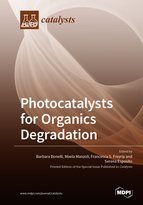Photocatalysts for Organics Degradation
A special issue of Catalysts (ISSN 2073-4344). This special issue belongs to the section "Photocatalysis".
Deadline for manuscript submissions: closed (31 July 2018) | Viewed by 32971
Special Issue Editors
Interests: surface properties of materials; nanoporous materials; TiO2 modification; photocatalysis; emerging pollutants' removal; IR spectroscopy; CO2 reduction
Special Issues, Collections and Topics in MDPI journals
Interests: surface properties and surface reactivity of polycrystalline solids of catalytic interest; supported noble metal nanoparticles; biomass conversion to value-added chemicals; microwave-assisted processes; ultrasound-assisted processes; selective hydrogenation; FT-IR and UV-Vis spectroscopies; gas volumetric measurements; X-ray diffraction; high-resolution transmission electron microscopy
Special Issues, Collections and Topics in MDPI journals
Interests: synthesis and characterization of heterostructured nanocrystals
Interests: sol–gel synthesis; porous materials; surface chemistry; oxide-based catalysts; metal-ceramic nanomaterials; zeolite precursors
Special Issues, Collections and Topics in MDPI journals
Special Issue Information
Dear Colleagues,
This Issue is devoted to papers concerning the synthesis, the physico-chemical properties and the performance of photo-catalysts for the degradation of organic pollutants. Research papers, reviews and perspectives dealing with the photo-catalytic degradation of most common organic pollutants (dyes, pesticides, herbicides, etc.) are welcome, as well as papers dealing with the removal of emerging ones, like drugs and their metabolites. Authors are encouraged to enlighten several aspects, including the synthesis of novel photocatalysts (hybrid materials, quantum dots, colloidal nanoparticles, doped mesostructured materials, etc..), the optimization of processes utilizing state-of-art photocatalysts and the influence of the physico-chemical properties of the photocatalyst on its final performance. Since one of the main issues related to the photocatalytic degradation of organic pollutants is their actual mineralization as well as the formation of by-products that can be per se harmful, a number of papers dealing with the correct determination of mineralization as with the detection of such by-products is expected.
Prof. Dr. Barbara Bonelli
Dr. Maela Manzoli
Dr. Francesca S. Freyria
Dr. Serena Esposito
Guest Editors
Manuscript Submission Information
Manuscripts should be submitted online at www.mdpi.com by registering and logging in to this website. Once you are registered, click here to go to the submission form. Manuscripts can be submitted until the deadline. All submissions that pass pre-check are peer-reviewed. Accepted papers will be published continuously in the journal (as soon as accepted) and will be listed together on the special issue website. Research articles, review articles as well as short communications are invited. For planned papers, a title and short abstract (about 100 words) can be sent to the Editorial Office for announcement on this website.
Submitted manuscripts should not have been published previously, nor be under consideration for publication elsewhere (except conference proceedings papers). All manuscripts are thoroughly refereed through a single-blind peer-review process. A guide for authors and other relevant information for submission of manuscripts is available on the Instructions for Authors page. Catalysts is an international peer-reviewed open access monthly journal published by MDPI.
Please visit the Instructions for Authors page before submitting a manuscript. The Article Processing Charge (APC) for publication in this open access journal is 2700 CHF (Swiss Francs). Submitted papers should be well formatted and use good English. Authors may use MDPI's English editing service prior to publication or during author revisions.
Keywords
- Novel synthesis of photocatalysts
- Water remediation
- Organic pollutants degradation
- Harmful by-products
- Advanced Oxidation processes
- Physico-chemical properties of photocatalysts
- Fenton, Fenton-like and photo-Fenton processes
- Scale-up of photocatalytic processes
- Detection of degradation products
- Mineralization/Decoloration









